The Chadar Trek in Ladakh, India is a canvas painted in frost and silence, where every step over the frozen Zanskar River feels like tracing nature’s most fragile artwork
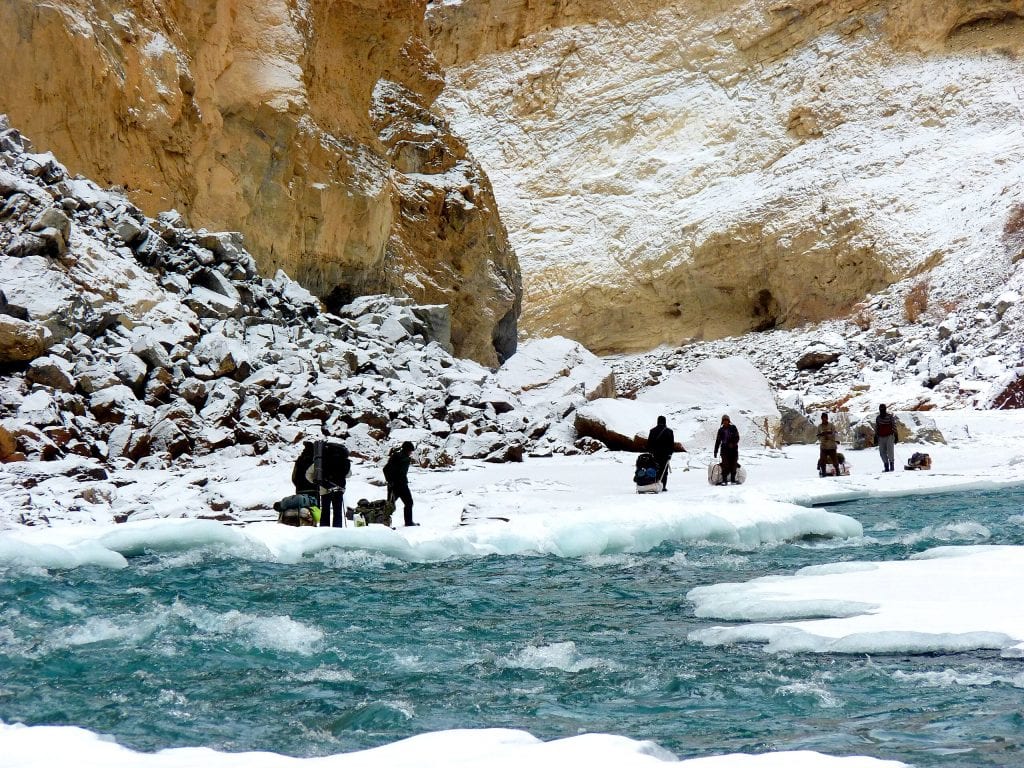
This trek is one of the most exciting and unique adventures in India and the world. It takes you across the frozen Zanskar River in Ladakh, offering breathtaking views and an experience like no other. This trek is not just about walking on ice but exploring the beauty of nature and pushing your limits in one of the coldest places on Earth.
What is the Chadar Trek?
The word “Chadar” means “sheet,” which describes the thick sheet of ice that forms on the Zanskar River during winter. From January to February, when temperatures drop as low as -30°C, the river freezes and creates a natural path for trekkers. Walking on this icy surface, surrounded by tall mountains and snowy landscapes, feels like stepping into another world.
The trek starts at Chilling, a small village near Leh, and covers about 105 kilometres over 6 to 9 days. Each day, the ice changes—sometimes it’s smooth and shiny, and other times it’s rough and uneven, making the journey full of surprises.
How difficult is Chadar Trek?
The Trek in the frozen environs of Ladakh, India, is renowned as one of the most challenging treks in the country. While the Trek is challenging it is also rewarding. You’ll walk for hours each day on slippery ice in freezing temperatures, testing your strength and patience. At night, you’ll camp in caves or tents under the starry Himalayan sky, listening to the stillness of nature.
One of the primary difficulties faced by trekkers is the extreme cold, with temperatures plunging to -40°C or even lower. Such harsh conditions significantly increase the risk of frostbite and hypothermia, requiring participants to take precautions to protect themselves from the biting cold.
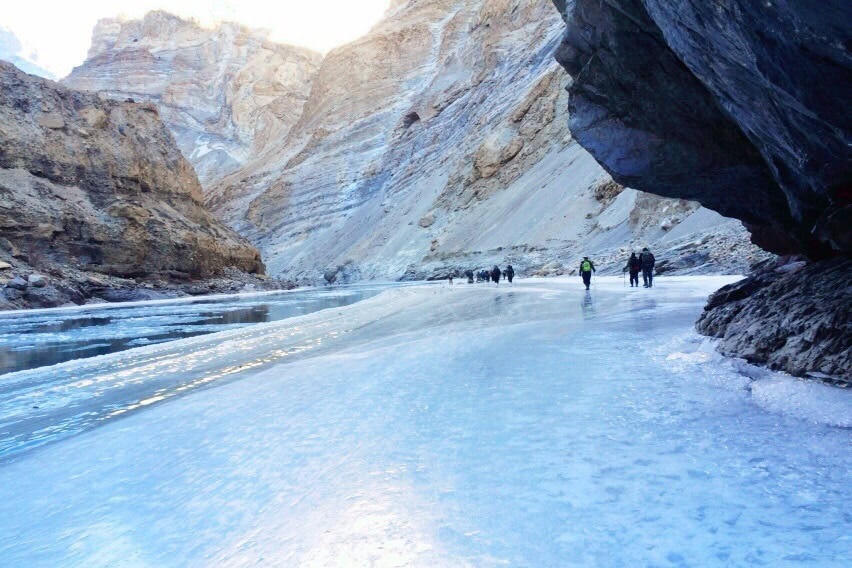
Another formidable challenge is the unstable ice of the frozen river, known as the “Chadar.” The ice can develop cracks or form thin, precarious layers, making it difficult to traverse. This instability demands constant vigilance and careful navigation to ensure safety. Adding to the unpredictability is the weather, which can shift suddenly, bringing unexpected rains or cold spells that intensify the already challenging conditions.
The trek also demands significant physical and mental preparation. Walking on ice requires specific techniques and skills to maintain balance and avoid accidents, making it essential for trekkers to train rigorously beforehand. The terrain itself is arduous, with its combination of slippery surfaces and uneven patches adding to the complexity of the journey.
Finally, the high altitude of the trek, which reaches up to 3,400 meters, poses another layer of adventure. The reduced oxygen levels at this elevation can lead to altitude sickness, for those undertaking this remarkable adventure. For those who brave these challenges, however, the Trek offers an unparalleled experience of Ladakh’s frozen landscapes and a profound sense of accomplishment.
Despite the tough conditions, the trek is full of magical moments. You’ll see frozen waterfalls, icy cliffs, and beautiful valleys that look like scenes from a movie. Each view is unique, and no two days on the trek are the same. It’s an adventure that will stay with you forever.
Meeting the Locals
The Chadar Trek is not just about nature; it’s also a chance to meet the Zanskari people, who live in villages along the way. These villagers have adapted to the harsh winter conditions and use the frozen river as a road to travel and trade. They are warm and welcoming, and you can learn a lot about their traditions and way of life.
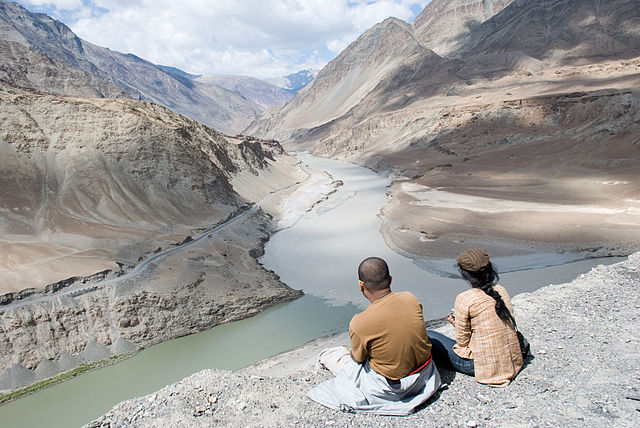
During the trek, you’ll also enjoy local food like butter tea and Thukpa (a noodle soup). Thukpa features wheat or barley noodles with vegetables or minced meat. Its spiced broth is both flavourful and warming. Variants like thentuk and pakthuk are enjoyed by locals and trekkers.
Skyu is another traditional soup-based dish made with vegetables and dough shaped into thumb-sized balls, cooked with water and vegetables over low heat. Often served with meat, it is a high-calorie meal perfect for Ladakh’s freezing winters and popular among trekking tourists. After a long day of walking, these simple meals feel like a feast and help you stay warm and energised.
How to Prepare for the Trek
The Chadar Trek requires proper preparation because of the extreme cold. You’ll need warm, layered clothing, insulated jackets, waterproof gloves, and sturdy trekking boots. Crampons are also important to help you walk safely on the ice.
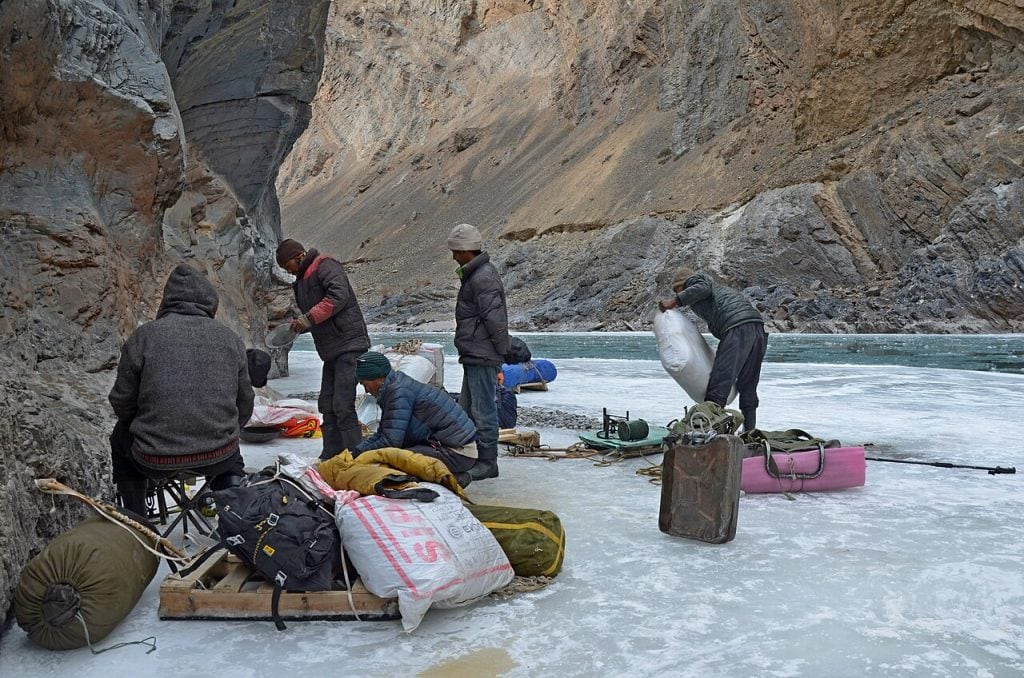
Since the trek is at a high altitude, you’ll need to spend a day or two in Leh to get used to the thin air. This will help prevent altitude sickness, which can be dangerous if not taken seriously. Drinking lots of water, eating well, and resting during this time is very important.
Detailed Itinerary for the Chadar Trek
This is an 8-day adventure across the frozen Zanskar River in Ladakh. A perfect balance of acclimatisation, safety, and exploration, this trek is one of the most unique experiences in the world.
How much does the Chadar Trek cost?
The 8-day trek average cost is between Rs 19,500 to 24,500
Day 1: Arrival in Leh (11,500 ft)
Your journey begins in Leh, the capital of Ladakh. Upon arrival, check into your guesthouse and spend the day resting and acclimatizing to the high altitude to prevent acute mountain sickness (AMS). Leh’s thin air can be challenging, so avoid overexertion.
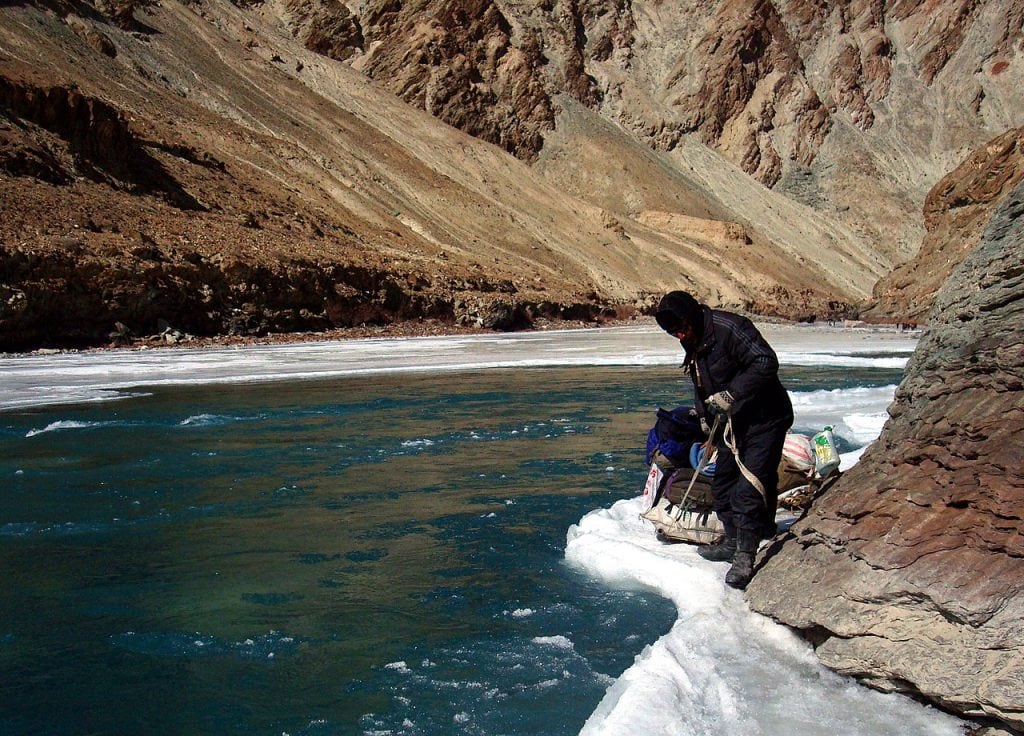
If you’re feeling up to it, explore the Leh Market, visit Shanti Stupa, or enjoy the serene views from Leh Palace. Early acclimatization is key to a successful trek, so hydrate well and keep warm.
Accommodation: Guesthouse in Leh.
Tip: Stay hydrated, eat light meals, and avoid physical exertion.
Day 2: Acclimatization in Leh and Trek Preparation
Spend another day in Leh to adjust further to the high-altitude environment. This is also the day to ensure your gear is ready for the trek. Attend a mandatory briefing session conducted by the trek leaders, where you’ll learn about the route, safety protocols, and what to expect on the ice.
Double-check your trekking equipment, including warm layers, insulated boots, crampons, gloves, and sleeping bags. Explore more of Leh at a leisurely pace, soaking in the vibrant culture and stunning Himalayan views.
Activity: Trek briefing, equipment check, and light exploration.
Tip: Enjoy hot fluids like butter tea or soup to stay warm.
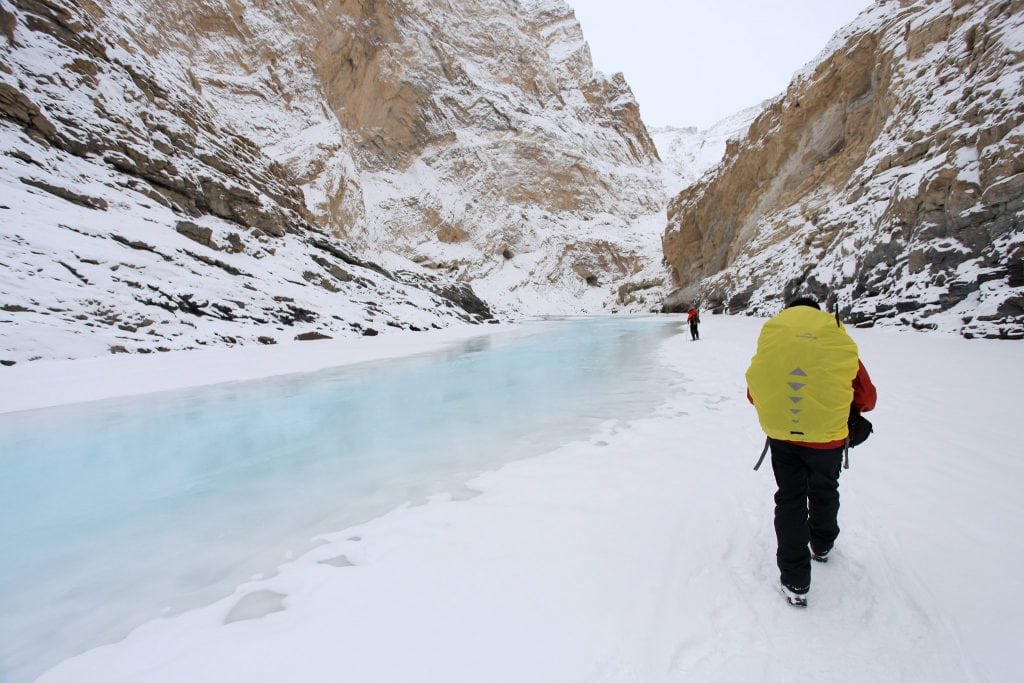
Day 3: Drive to Chilling and Trek to Tilad Do (10,390 ft)
- Drive Duration: 3-4 hours (Leh to Chilling).
- Trek Distance: 2-3 km (Chilling to Tilad Do).
The day starts with a picturesque drive to Chilling, the starting point of the trek. En route, marvel at the confluence of the Indus and Zanskar Rivers and the rugged Himalayan landscapes. Once at Chilling, you’ll begin your trek with a short 1-2 hour walk along the icy Zanskar River to Tilad Do, the first campsite.
Experience your first-night camping by the frozen river, surrounded by pristine snow-clad peaks.
Accommodation: Tents at Tilad Do.
Activity: Scenic drive, short trek, and camping.
Tip: Practice walking on ice to familiarize yourself with the terrain.
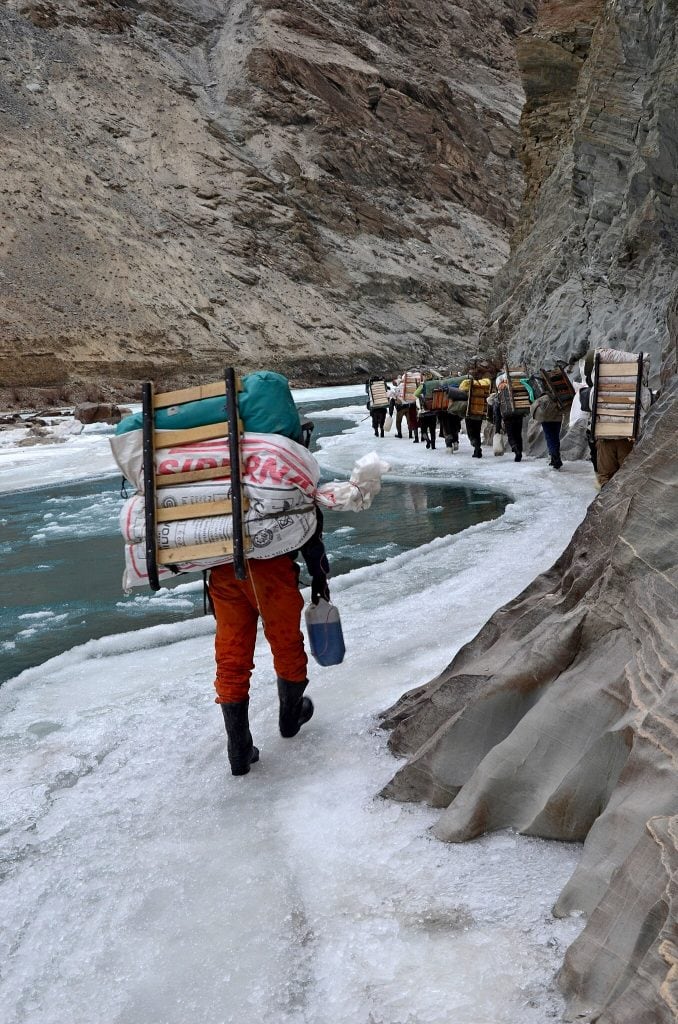
Day 4: Trek from Tilad Do to Shingra Koma (10,550 ft)
- Trek Distance: 10 km (4-5 hours).
Start early to trek over the frozen river surface, where the icy patterns and cracks create mesmerizing textures. Walk through narrow gorges flanked by towering cliffs and marvel at the interplay of sunlight on the frozen river. The trek to Shingra Koma is relatively gentle, allowing you to adjust to the icy terrain.
Accommodation: Tents at Shingra Koma.
Activity: Trekking on the frozen Zanskar, camping, and storytelling by the bonfire.
Tip: Use crampons for better grip and keep your pace steady to avoid slipping.
Day 5: Shingra Koma to Tibb Cave (10,800 ft)
- Trek Distance: 14 km (6-7 hours).
This is a longer trekking day, offering dramatic views of the frozen river and snow-covered cliffs. Along the way, you’ll encounter frozen waterfalls and patches of crystal-clear ice. Reach Tibb Cave, a natural shelter nestled amidst the rugged landscape, where you’ll set up camp.
Accommodation: Tents at Tibb Cave.
Activity: Explore the cave and enjoy the solitude of the wilderness.
Tip: Wear insulated gloves and keep warm to avoid frostbite.
Day 6: Tibb Cave to Nerak Waterfall (11,150 ft)
- Trek Distance: 12 km (6-7 hours).
The trek to Nerak Waterfall is the highlight of the journey. This spectacular frozen cascade is a natural marvel, with icicles shimmering in the sunlight. The route offers stunning vistas of snow-laden landscapes and ice sculptures. Camp near the waterfall, marking the furthest point of the trek.
Accommodation: Tents near Nerak.
Activity: Photography at Nerak Waterfall and camping.
Tip: Keep your camera batteries warm to avoid losing charge in the cold.
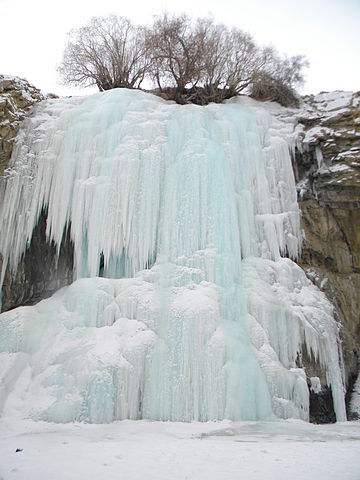
Day 7: Return Trek to Tibb Cave
- Trek Distance: 14 km (6-7 hours).
Retrace your steps along the frozen river to Tibb Cave. The familiarity of the route makes the return journey slightly easier, allowing you to relax and appreciate the scenery.
Accommodation: Tents at Tibb Cave.
Activity: Reflect on your experiences and share stories with fellow trekkers.
Tip: Monitor ice conditions as they may have changed since your first pass.
Day 8: Trek to Shingra Koma and Drive to Leh
- Trek Distance: 12 km (5-6 hours).
- Drive Duration: 3-4 hours (Shingra Koma to Leh).
Complete the final stretch of your trek to Shingra Koma, where a vehicle will be waiting to take you back to Leh. The scenic drive back is a moment to celebrate your achievement and relive the incredible memories of the trek.
Accommodation: Guesthouse in Leh.
Activity: Relaxation and celebration in Leh.
Tip: Treat yourself to a warm meal and rest after your adventure.
Protecting the Environment
The Trek also teaches us about the effects of climate change. Rising temperatures have made the ice on the Zanskar River less stable in recent years, making the trek more unpredictable. It’s a reminder of how important it is to protect nature.
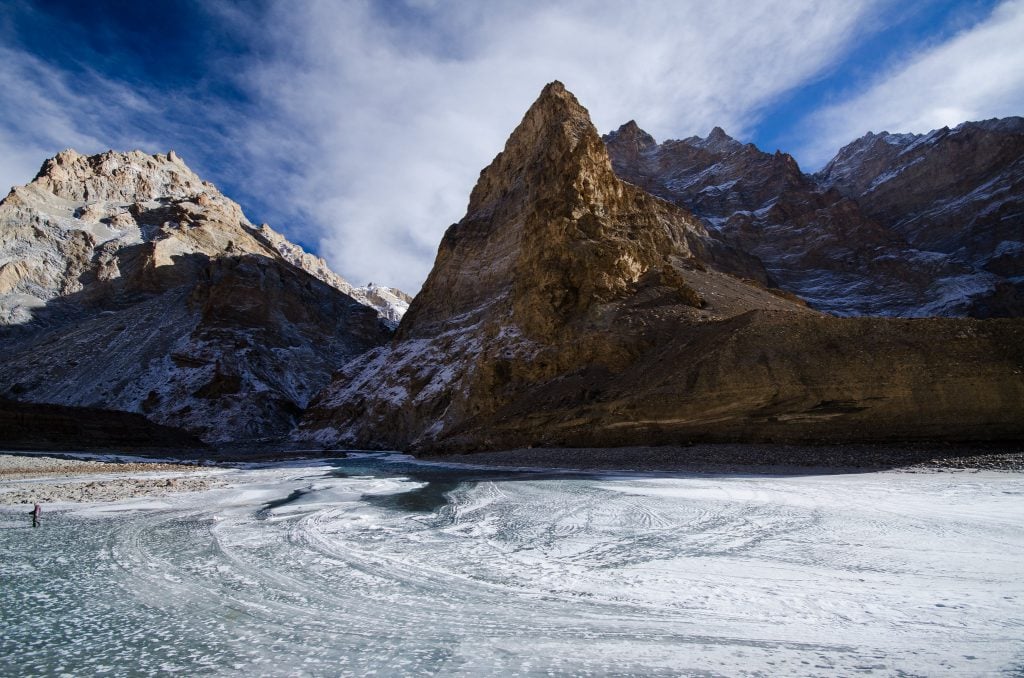
Trekkers are encouraged to follow eco-friendly practices, like avoiding plastic, not leaving waste behind, and respecting the local culture. This helps preserve the beauty of the region for future adventurers.
Why the Chadar Trek is Special
The Chadar Trek is not just a trek—it’s an unforgettable experience. Walking on a frozen river, surrounded by stunning winter landscapes, makes you feel closer to nature and yourself. It’s a journey of adventure, discovery, and awe.
If you’re someone who loves challenges and wants to experience something truly unique, the Trek is perfect for you. Pack your warmest clothes, prepare your mind and body, and get ready for an adventure that will stay in your heart forever.
Read more: Discover Your India



